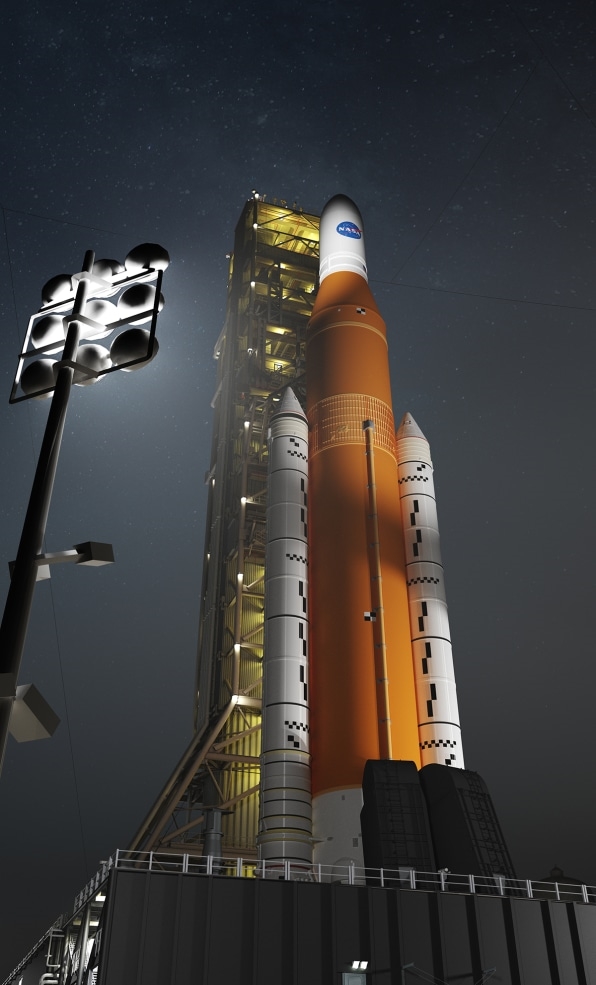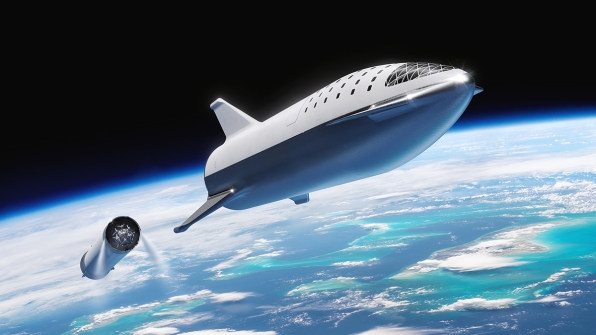The 50th anniversary of the Apollo moon landing is an occasion for great historical celebration, but also concern at the present state of human space exploration, at least for the United States. Years of political back-and-forth and technical setbacks threaten to drag on longer than the entire Apollo program took. Meanwhile, the prospects for a deus ex machina by Elon Musk’s SpaceX have dimmed at least slightly after a series of mishaps during rocket tests this year. As for Jeff Bezos’s Blue Origin, that’s even years behind SpaceX.
And then there’s President Trump’s stated aim to make America great again in space, which appear to be as fraught as the rest of his mercurial policy goals. In March, Vice President Mike Pence (who energetically chairs the National Space Council) declared that U.S. men and women would walk on the moon by 2024—up from the planned 2028 goal. But then earlier this month, Trump tweeted that the U.S. should aim straight for Mars and called it a waste of money to go the moon. In place of a Saturn V rocket, we have a saturnine chief executive.
Elements of the administration still seem committed to the moon, and frustrated with NASA’s progress. On July 10, NASA administrator Jim Bridenstine announced that he was reassigning two top executives, “to better position the agency to meet the challenge to go forward to the moon and on to Mars.”
Even if the president were laser-focused on the moon, such plans rarely survive. The move to 2024 has one obvious reason: It would be the last year of a second Trump term—far from certain for a commander in chief whose approval rating has never cracked 50%.
Trump’s predecessor, Barack Obama, dissed the idea of a return to the moon, instead pushing for a mission to an asteroid and, later, Mars. That nixed the policy of his predecessor, George W. Bush, who included a return to the moon in his space agenda (along with a Mars mission). And Bush’s policy reversed that of his predecessor’s: Bill Clinton focused on low-Earth orbit. (Work on the orbiting International Space Station began during his presidency.) Indeed, routine flip-flops in this area go all the way back to the Eisenhower administration.
The politics of the original moon mission were also fraught. Like President Trump, public approval of the Apollo program never hit even 50%—aside from a brief period right after the first landing. Even President Kennedy expressed deep doubts (though privately) toward the end of his short life. An outpouring of sympathy for the slain president may have been what sustained the dream.
Technical difficulties
But at least the science of Apollo progressed throughout the political storm—unlike today. From a pledge by Kennedy in 1961, NASA built an unprecedented amount of technology (at the unprecedented cost of perhaps $288.1 billion in today’s dollars and 2.8 billion hours of labor by up to 410,000 people). The Saturn V—a 363-foot-tall rocket that rose on 7.5 million pounds of thrust—remains the mightiest launch vehicle ever flown. SpaceX’s Falcon Heavy, the most powerful rocket today, has about 5 million pounds of thrust.
The Saturn V was literally the work of an evil genius—Nazi engineer Wernher von Braun, creator of Hitler’s V2, the world’s first long-range guided ballistic missile. America’s own engineering prowess was so poor that it had to import expertise, at any ethical cost. As the musical Hamilton proclaims: “Immigrants, we get the job done.”

[Artist Rendering NASA’s SLS, Photo: NASA]
Meanwhile, NASA’s successor to the Saturn V, the Space Launch System (SLS), is dragging along. Cobbled together from tech leftovers of the Space Shuttle (a program begun over 40 years ago), SLS will produce 11.9 million pounds of thrust to get more equipment and people (four instead of three) to the moon.
But it’s not certain that SLS—key to NASAs Artemis lunar program—will get off the ground. The estimated bill is up to $8.9 billion through 2021—double the initial projection. The first launch, originally scheduled late 2017, might not happen until June 2021.
The SLS is built by Boeing, a company whose reputation has been in freefall. Two crashes and the persistent global grounding of the 737 Max airliner are only part of it.
Given this mess, hope has turned to Silicon Valley fast movers Elon Musk and Jeff Bezos. (VP Pence even floated the idea of dumping SLS in favor of other companies’ products.)
Musk’s SpaceX is beating Boeing in getting U.S. astronauts back into orbit—a capability lost in July 2011 with retirement of the Space Shuttle. SpaceX’s Crew Dragon successfully docked with the ISS in March (in an uncrewed robotic mode).
Then the explosion happened. In April, a ground-based test of the emergency abort system for Crew Dragon blew up, and this week, SpaceX and NASA released the results of an investigation showing that the mishap was caused by a faulty valve.
Finding a cause bodes well for engineering a fix, but SpaceX expressed doubt that its first crewed mission to the ISS, originally planned for this month, will happen this year. Boeing’s (robotic) test of a crew-capable capsule is forecast for August, but delays are always possible.

[Artist Rendering SpaceX, Photo: SpaceX]
Meanwhile, SpaceX is moving ahead with its next generation of craft—a massive rocket called Super Heavy (with over 11 million pounds of thrust) and a comparatively massive crewed vehicle called Starship. Musk has announced plans to send a contingent of seven to nine people (led by billionaire Yusaku Maezawa) around, but not landing on, the moon as soon as 2023. (Just this week, however, he said that a human landing might be possible within four years.)
In May, Jeff Bezos announced that Blue Origin will launch a moon-capable rocket called New Glenn in 2021. He also previewed a lander to deliver supplies and humans to the surface, some day. But Bezos has yet to even launch a rocket into orbit.
Musk had forecast a “hopping” test of a Starship prototype for this week—hovering about 66 feet over the launch pad. If it went well, he might launch the prototype up to 12 miles later this year. (NASA considers about 50 miles above sea level to be the beginning of “space.”) But shortly after a preliminary engine test, the launch pad bust into flames from leaked fuel that caught fire. Musk tweeted that the craft, shielded to survive a fiery reentry to the atmosphere, was not hurt by the fire, and that a hop test might happen next week.
A new hope in Asia
All hope doesn’t ride on the United States, however. In January, China landed its Chang’e 4 on the moon’s far side—the first craft to achieve the feat. Later this year, it aims to land the Chang’e 5 robotic probe to collect rock samples and return them to Earth—for the first time since the Apollo landings. China has also announced plans (without firm dates) for a human moon landing and even a moon base in the future, portending a potential new space race.
On July 22, India aims to launch its first lander and rover mission, Chandrayaan-2, to reach the moon’s south pole, and it wants to put humans in orbit by 2022. Earth orbit is a long way from the moon, but Kennedy’s first moon speech came nearly a year before John Glenn became the first American in orbit.
Apollo planted an American flag on the moon 50 years ago. It’s still there, but over the decades, it’s faded to the point of being unrecognizable. It’s unclear when it will get a replacement.
(49)